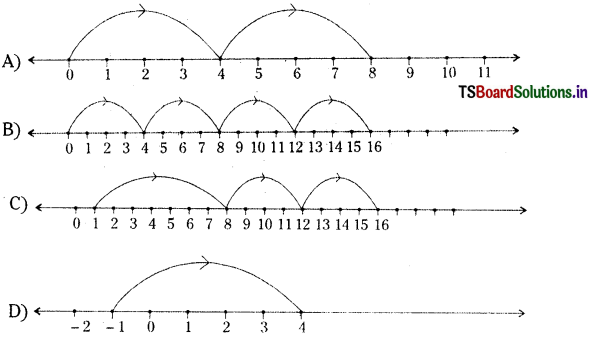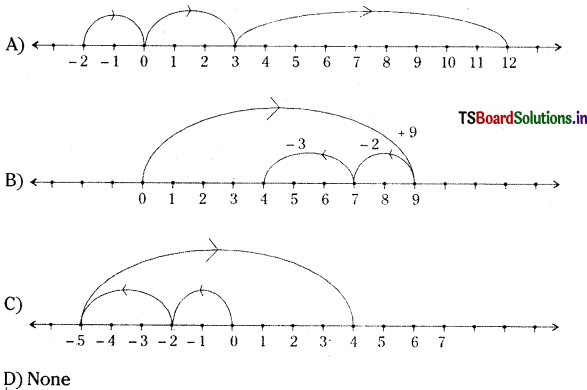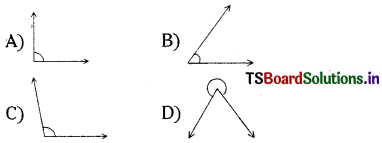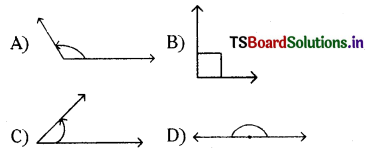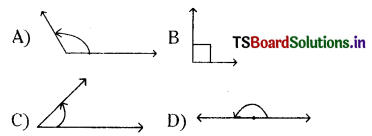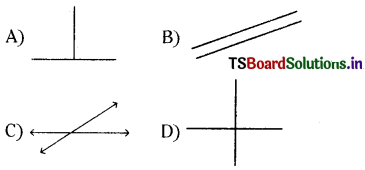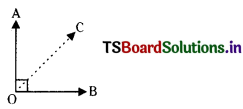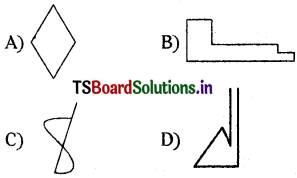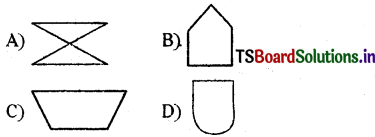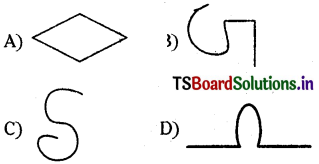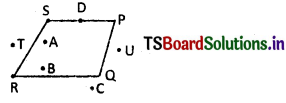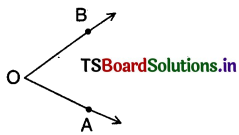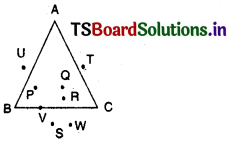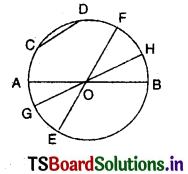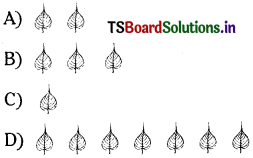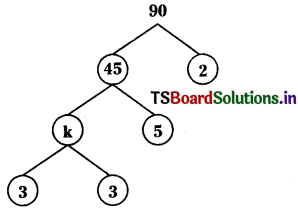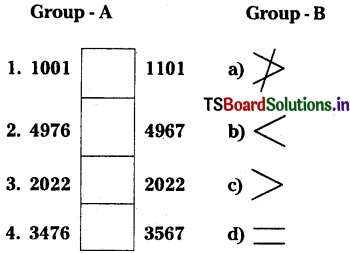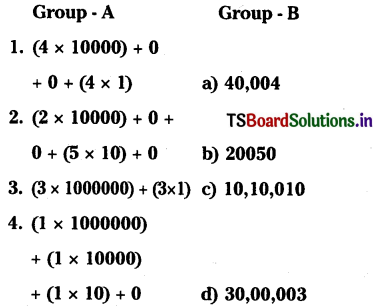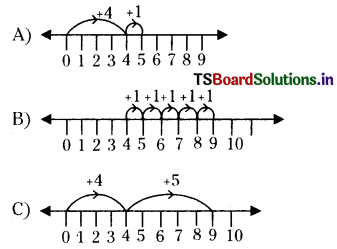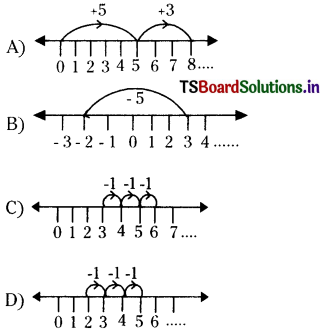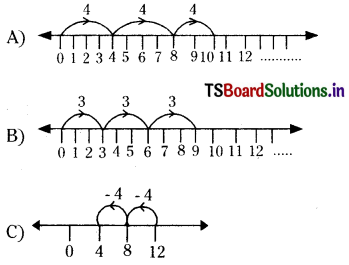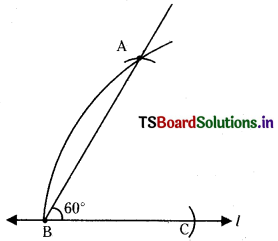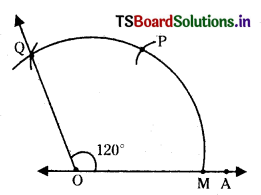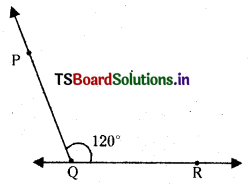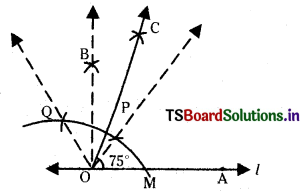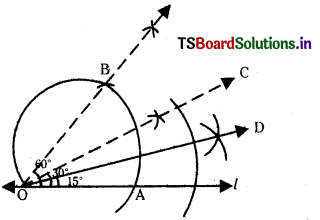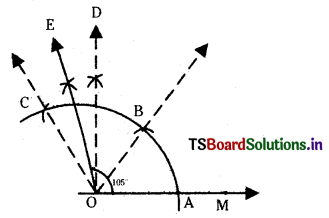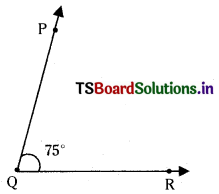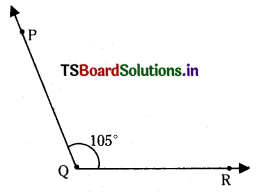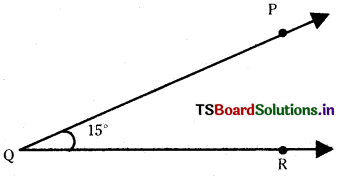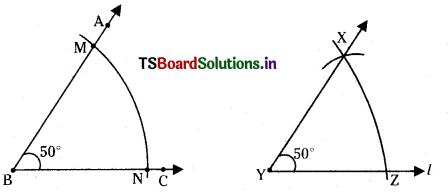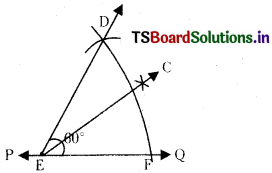Solving these TS 6th Class Maths Bits with Answers 9th Lesson Introduction to Algebra Bits for 10th Class will help students to build their problem-solving skills.
TS 6th Class Maths Bits Chapter 9 Introduction to Algebra
Question 1.
For which value of m, 4m = 20 ?
A) 24
B) 3
C) 5
D) 16
Answer:
C) 5
Question 2.
The solution of 6x = 24 is _______.
A) 18
B) 6
C) 4
D) 30
Answer:
C) 4
Question 3.
If m = 2, the value of 5m + 6 is
A) 11
B) 26
C) 21
D) 16
Answer:
D) 16
Question 4.
The value of p which satisfies the equation 2p – 1 = 5 is
A) 1
B) 2
C) 6
D) 3
Answer:
D) 3
![]()
Question 5.
The value of l which satisfies the equation 7l + 1 = 15 is
A) 1
B) 2
C) – 1
D) 0
Answer:
B) 2
Question 6.
Value of 5p – 4 when p = 0 is
A) – 4
B) 1
C) 6
D) 11
Answer:
A) – 4
Question 7.
Value of – x + 5 when x = – 1 is
A) 4
B) 6
C) 3
D) 7
Answer:
B) 6
Question 8.
Value of \(\frac{2 m-1}{5}\) when m = 3 is
A) 0
B) – 1
C) 1
D) \(\frac{1}{5}\)
Answer:
C) 1
![]()
Question 9.
For which value of t, the LHS and RHS of t – 1 = 6 are equal ?
A) 7
B) 6
C) 4
D) 5
Answer:
A) 7
Question 10.
The expression for “11 subtracted from 2m” is
A) 2m – 11
B) 11 – 2m
C) 2m + 11
D) 22m
Answer:
A) 2m – 11
Question 11.
The expression for “8 added to 2 times p” is
A) 8 + p
B) p + 16
C) 8 + 2p
D) 16p
Answer:
C) 8 + 2p
Question 12.
The expression for “- p multiplied 5” is
A) – 5p
B) – p + 5
C) p + 5
D) \(\frac{-5}{p}\)
Answer:
A) – 5p
![]()
Question 13.
Suresh is 12 years old. Ramesh’s age is x years more than that of Suresh. So, the age of Ramesh is
A) 12 + x
B) x – 12
C) 12 – x
D) 12x
Answer:
A) 12 + x
Question 14.
The expression for “5 times y from which 3 is subtracted” is
A) 3 – 5y
B) 5y – 3
C) 5 + 3y
D) y + 15
Answer:
B) 5y – 3
Question 15.
The expression for “10 added to 3 times of p”
A) 30 + p
B) 10p + 3
C) 10 + 3p
D) 30p
Answer:
C) 10 + 3p
Question 16.
Saritha’s present age is ‘y’ years. Her age 3 years back was
A) y + 3
B) 3 – y
C) 3y
D) y – 3
Answer:
D) y – 3
![]()
Question 17.
Grandfather is 4 years older than grandmother. If the age of grand¬mother is x years, then the age of grandfather is
A) x + 4
B) 4 – x
C) 4x
D) x – 4
Answer:
A) x + 4
Question 18.
Number of pencils with Rama is 3 more than Raja. Find the number of pencils with Rama in terms of what Raja has
A) p + 3
B) y – 3
C) x × 3
D) \(\frac{z}{3}\)
Answer:
A) p + 3
Question 19.
A number is twice less than three. The number can be expressed as _______
A) \(\frac{2 x}{3}\)
B) 2x + 3
C) \(\frac{x}{2}\) – 3
D) 2x – 3
Answer:
D) 2x – 3
Question 20.
If the cost of one pen is 11. What is the cost of 12 such pens ?
A) ₹ 122
B) ₹ 132
C) ₹ 121
D) ₹ 134
Answer:
B) ₹ 132
![]()
Question 21.
Write an expression for the statement “7 times of q is subtracted from twice of p”
A) 7p – 2q
B) 7 (p – 2q)
C) 2p – 7q
D) 2 (p – 7q)
Answer:
C) 2p – 7q
Question 22.
Write an expression for “y is divided by 4 and 7 is subtracted from Quotient”.
A) \(\frac{y}{4}\) – 7
B) 4y – 7
C) \(\frac{4}{y}\) – 7
D) \(\frac{y}{4}\) + 7
Answer:
A) \(\frac{y}{4}\) – 7
Question 23.
Perimeter of a square of side ‘a’ is
A) a2
B) 4a
C) a3
D) 4a2
Answer:
B) 4a
Question 24.
What is the area of a square, whose side is ‘p’ units (in sq. units) ?
A) 4p2
B) p3
C) 4p
D) p2
Answer:
D) p2
![]()
Question 25.
What is the perimeter of an equilateral triangle, whose side is ‘x’ units ?
A) 3x2
B) \(\frac{\sqrt{3}}{4}\)x2
C) 3x
D) \(\frac{\sqrt{3}}{2}\)x
Answer:
C) 3x
Question 26.
L.H.S of – 7 = 2l – 5 is
A) – 7
B) 2l – 5
C) 2
D) – 2
Answer:
A) – 7
Question 27.
R.H.S of 3z + 2 = 5 – 3z
A) 3z + 2
B) 5 – 3z
C) 3
D) 2
Answer:
B) 5 – 3z
Question 28.
If x – 3 = – 5 then x =
A) 2
B) – 2
C) 8
D) – 8
Answer:
B) – 2
![]()
Question 29.
If \(\frac{1}{2 z}=-\frac{7}{6}\) then z = _______
A) \(\frac{-3}{7}\)
B) \(\frac{-7}{3}\)
C) \(\frac{3}{7}\)
D) \(\frac{-4}{3}\)
Answer:
A) \(\frac{-3}{7}\)
Question 30.
Which of the following is an equation?
A) 3x < 5
B) – < 3 C) 2p = 14 D) l + 5 > 9
Answer:
C) 2p = 14
Question 31.
If – 15 = \(\frac{- 3p}{2}\)
⇒ p = _______
A) – 5
B) 5
C) – 10
D) 10
Answer:
D) 10
Question 32.
Which of the following is not a variable ?
A) a
B) l
C) 2
D) x
Answer:
C) 2
![]()
Question 33.
2x – 5 =
i) 5 is subtracted from twice of x
ii) 5 is subtracted from two times of x
iii) the difference of 5 and 2x
A) only (i) is true
B) only (i) & (ii) are true
C) only (ii) is true
D) only (iii) is true
Answer:
B) only (i) & (ii) are true
Question 34.
\(\frac{11 x-5}{7}\) =
i) 5 is subtracted from 11 times of x and the difference is divided by 7.
ii) 11 times of x is subracted from 5 and is divided by 7.
iii) the difference of 11x and 5 is multiplied by 7.
A) only (i) is true
B) only (ii) is true
C) only (iii) ¡s true
D) (i), (ii) & (iii) are all false
Answer:
A) only (i) is true
Question 35.
\(\frac{z}{5}\) – 3 =
i) 3 is subtracted from one – fifth of z
ii) one – fifth of z is subtracted from 3
A) Both (i) & (ii) are true
B) (i) – is true and (ii) is false
C) (i) – is false and (ii) is true
D) Both (i) & (ii) are false
Answer:
B) (i) – is true and (ii) is false
Question 36.
Match the following :
| Group – A | Group – B |
| 1. If x – 3 = – 8 ⇒ x = ______ | a) 7 |
| 2. If \( \frac{k-1}{2}=\frac{2+k}{3} \) ⇒ k = _______ | b) 5 |
| 3. If 7 (p – 1) = 5 (p + 2) ⇒ p = _____ | c) – 5 |
| d) 17 / 2 |
A) 1 – a, 2 – b, 3 – c
B) 1- b, 2 – c, 3 – d
C) 1 – c, 2 – a, 3 – d
D) 1 – c, 2 – b, 3 – d
Answer:
C) 1 – c, 2 – a, 3 – d
![]()
Question 37.
Match the no. of sticks are used in each patterns of the following figures :
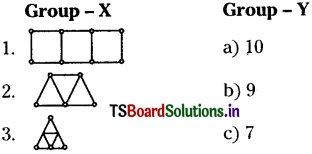
A) 1 – a, 2 – c, 3 – b
B) 1 – a, 2 – b, 3 – c
C) 1 – c, 2 – b, 3 – a
D) 1 – b, 2 – c, 3 – a
Answer:
A) 1 – a, 2 – c, 3 – b
Question 38.
Match the patterns of the following figures:
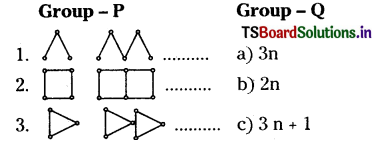
A) 1 – a, 2 – b, 3 – c
B) 1 – b, 2 – c, 3 – a
C) 1 – b, 2 – a, 3 – c
D) 1 – a, 2 – c, 3 – b
Answer:
B) 1 – b, 2 – c, 3 – a
Question 39.
What is the pattern of the series 2, 4, 6, 8 _______?
A) \(\frac{p}{2}\)
B) 2p
C) 2p
D) 2 + p
Answer:
C) 2p
Question 40.
What is the pattern of 3, 6, 9, 12, _______?
A) 3p
B) 3p
C) \(\frac{3}{p}\)
D) 3 + p
Answer:
A) 3p
![]()
Question 41.
What is the pattern of the letter ‘H’ ?
A) 3x
B) 2x
C) 4x
D) x
Answer:
A) 3x
Question 42.
What is the pattern of the series 4, 7, 10, 13, _______ ?
A) 3s – 1
B) 3s + 1
C) 3s + 2
D) 2s + 1
Answer:
B) 3s + 1
Question 43.
A pattern of letter ‘T’ is _______
A) s2
B) 2 + s
C) 2s
D) s + 1
Answer:
C) 2s
Question 44.
Find the rule for the pattern.
![]()
A) 4s + 1
B) 2s + 1
C) 3s + 1
D) 4s – 1
Answer:
D) 4s – 1
![]()
Question 45.
If the cost of one bag is ₹ 110, then what is rule for the cost of ‘m’ bags ?
A) 110 + m
B) 110 m
C) \(\frac{110}{m}\)
D) 110m
Answer:
B) 110 m
Question 46.
In a pattern 5a – 1 if a = 4 then 5a – 1 = ?
A) 9
B) – 19
C) 21
D) 19
Answer:
D) 19
Question 47.
What is the nth term of the sequences 2, 5, 8, 1 _______?
A) 3p + 1
B) 3p – 1
C) 2s + 1
D) 4p – 1
Answer:
B) 3p – 1
Question 48.
The n,h term of the sequences 1, 4, 9, 16, 25 ……….. is
A) y
B) 2s
C) s2
D) s3
Answer:
C) s2
![]()
Question 49.
Which of the following is a root of 2n + 5 = 27 ?
A) 11
B) 12
C) 10
D) 9
Answer:
A) 11
Question 50.
In 2x + 3 = 9, x is called the
A) power
B) variable
C) constant
D) degree
Answer:
B) variable
Question 51.
The LHS of 3y + 8 = 11 is
A) 11
B) 3y
C) 8
D) 3y + 8
Answer:
D) 3y + 8
Question 52.
The RHS of 10 = 7p + 16 is
A) 10
B) 7p + 16
C) 7p
D) 16
Answer:
B) 7p + 16
![]()
Question 53.
Represent the following statement in an equation “7 is subtracted from 4 times of x and the differene is equal to 21”
A) 4x – 7 = 21
B) 4x + 7 = 21
C) 4x- 21 = 7
D) 4x + 21 = 7
Answer:
A) 4x – 7 = 21

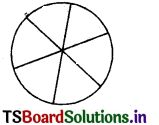
 the shaded portion represents the fraction ______
the shaded portion represents the fraction ______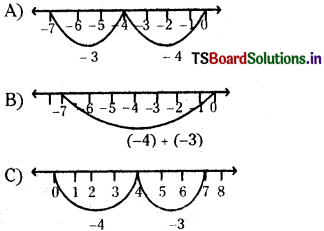

 represents
represents

